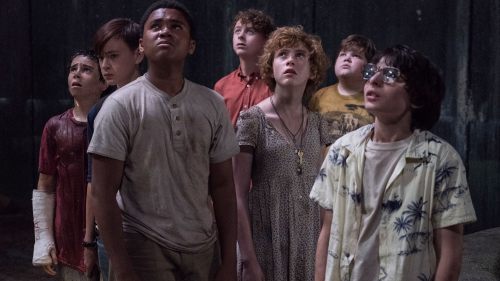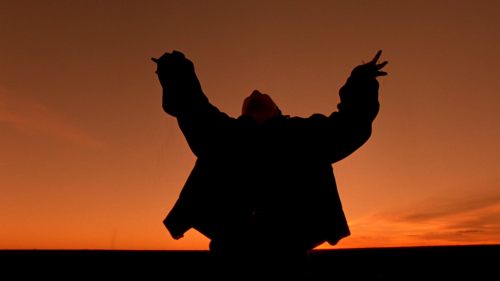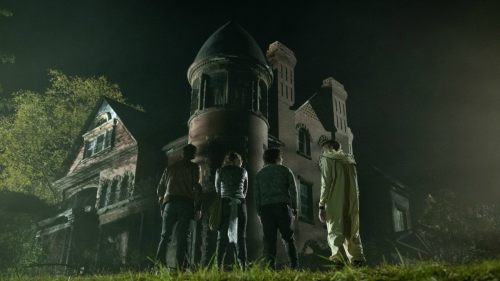THE AUTOPSY OF JANE DOE And The Power Of Folk Tales
Scary Stories to Tell in the Dark is almost here and we have a super cool magazine about it. You can get that here. For tickets to the film, go here!
WARNING: This article contains spoilers for The Autopsy of Jane Doe. If you haven't seen it, it's on Netflix. Go on, this can wait.
Most people like a good scary story, whether or not they consider themselves fans of the horror genre. It’s a fairly universal practice to tell stories meant to titillate and dabble with danger by proxy, emblemized in American popular culture by the campfire story. These are the folk tales by which we define the boundaries of our safety and safely explore their limits, imparting lessons onto children and teenagers to not be reckless in the dark and to be wary of that which is strange and different. These stories have a form that compliments their function, so much so that even a parodic word jumble like the infamous “Man Door Hand Hook Car Door” communicates that form through sheer structural fidelity. And while the setting may not be the usual venue for such folk tales, André Øvredal’s The Autopsy of Jane Doe is a fantastic example of that form put to good use for horror filmmaking.
The key to any good folk tale is relatability, and at first glance, The Autopsy of Jane Doe is not necessarily a relatable setting. Working in a morgue is not exactly a universal experience, but what most of us do have is family, which Øvredal uses to ground his spooky story in terms that immediately spark recognition. Austin (Emile Hirsch) acts as assistant to his mortician father, Tommy (Brian Cox), and it’s easy to see how their relationship is foundationally loving, yet antagonistic in the details. Tommy constantly corrects Austin’s diagnoses of cause of death and shoots down Austin’s attempts to deduce motive rather than physical cause. Austin, meanwhile, feels beholden to his father’s apparent dependence after the death of Austin’s mother, even as he contemplates pursuing a life away from his father’s career to start a life with his girlfriend, Emma (Ophelia Lovibond). The relationship is archetypal, but that simply means that we understand these characters instantly and know how we ourselves would relate to their dynamic, and it's Austin’s tie to that dynamic that draws him into the autopsy of the newly arrived Jane Doe.
This introduces our next touchstone of the American folk tale: the mystery. Often, we’re drawn into tales of the supernatural or the macabre by our incomplete understanding of the forces acting against the protagonists and, by extension, us. Morticians are investigators of the macabre, which makes their position perfect to unravel the mysteries of a body that has seemingly suffered extensive internal injuries but is nevertheless externally flawless and unharmed. Jane Doe never moves or speaks, so even though she is eventually revealed to have something approximating personality, she is effectively mythic through the lack of personification. We often think of iconography in relation to what we fear could be lurking in the dark, like hooks, claws, or haunting laughter, but Jane Doe herself is effectively the icon of her own bizarre happenings, a human-shaped MacGuffin around which to center a creepy tale.
Folk tales are also antagonistic to our desire to know and learn the cause of the things that terrify us just outside the light’s range, which means that as we come closer to learning the truth behind the unexplainable, the further our terror and sanity is pushed to the limits, which is exactly the sort of literal push Jane Doe exerts on Austin and Tommy. Ostensibly, a storm locks father and son in the mortuary, but we later learn that this reality only seems to extend to Austin and Tommy’s experience, as the radio claims clear skies and Emma has no issue returning to pick Austin up for their date. A chilling rendition of “Open Up Your Heart (And Let The Sunshine In)” plays unprovoked on the radio. Blurred figures stand in the hallway just out of focus, and the repetitive tinkle of a bell tied to a corpse’s toe harkens its slow and steady approach. This is the kind of escalation that climaxes in the cinematic equivalent of your camp counselor shouting “BOO!” as the tension reaches its breaking point, and unlike jump scares that rely on silence to reinforce the shock of the attendant surprise, folk stories are all about the repetitive nature of their telling, lulling you into a cyclical fear that is exploited by snapping you out of trance.
But perhaps most importantly to any good folk tale, The Autopsy of Jane Doe denies you the resolution of a clean ending. If this were a story about character growth and human survival against forces larger than ourselves, then the climax would be where Austin finally lets his dad go after convincing him to investigate more than the physical causes of Jane Doe’s death. In that instance, both characters would have functionally completed a character arc with no loose ends. But Austin’s expository knowledge of Jane Doe's witchy origins isn’t enough to save him in the end, and once the police discover the destruction left in her wake, Jane Doe is carried on to the next morgue, to the next victim. Dear viewer, she is still out there somewhere, and if you should be so unlucky as to come across this immaculate corpse, then you too might fall victim to her vengeance, regardless of how well you understand her history and motivations. The ghosts and monsters of folks stories cannot be reasoned with, cannot be deconstructed or rationalized. In the end, we are just fodder to their senselessness, just as their senselessness is fodder for our stories. André Øvredal’s next film, Scary Stories to Tell in the Dark, is an adaptation of a series of stories that understood the intrinsic, cathartic value of terrifying folk tales. But The Autopsy of Jane Doe demonstrates his innate understanding of the power of folk tales by creating his own, which makes the prospect of his take on established terrors all the more appealing.



